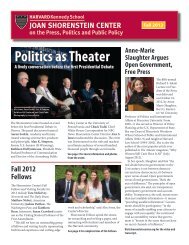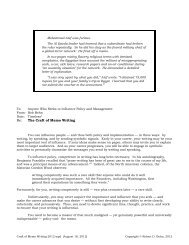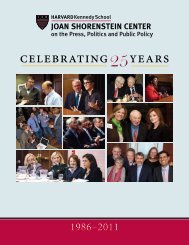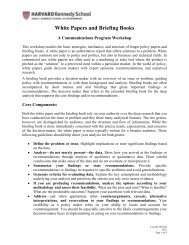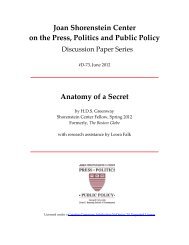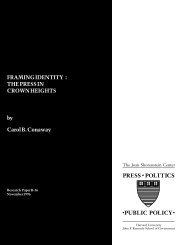A User-First Framework for Sustaining Local News - Harvard ...
A User-First Framework for Sustaining Local News - Harvard ...
A User-First Framework for Sustaining Local News - Harvard ...
You also want an ePaper? Increase the reach of your titles
YUMPU automatically turns print PDFs into web optimized ePapers that Google loves.
In addition to charging by niche, the new online subscription services enable<br />
publishers to adjust free/paid dials based on number of articles viewed and the timing of<br />
publication. Some may also invite readers to set their own price, depending on the value<br />
they attach to the content at hand.<br />
A chart from a Journalism Online presentation shows how a publisher might decide<br />
to reserve access to certain articles to paying customers <strong>for</strong> a period of, say, one hour<br />
after publication. For big news of widespread interest, the publisher could remove the<br />
meter and make the story available immediately to all. Whether restricted by timestamp<br />
or not, the advantage of such an approach is that it avoids sealing news off behind a pay<br />
wall and thwarting the ability to build as big an audience as possible. 66<br />
Audience building—or content swiping, depending on your point of view—is at the<br />
heart of the dispute between Google and some news executives. That controversy is<br />
beyond the scope of this paper, but Google’s “<strong>First</strong> Click Free” service is worth noting in<br />
the context of emerging pay wall options.<br />
In a December 1 post, Jeff Cohen, a senior business product manager <strong>for</strong> Google, said<br />
the search engine had updated the service to enable publishers to limit readers to no<br />
more than five articles per day. 67 This approach enables the so‐called metered approach<br />
used by the Financial Times and planned by The New York Times.<br />
The idea, according to U.S. FT managing editor Christia Freeland, “is to be<br />
simultaneously open to visits from the occasional and casual newcomer while assuring<br />
that the addict has to pay <strong>for</strong> his addiction.” In practical terms, this means you can visit<br />
FT.com 10 times in a month be<strong>for</strong>e a pay wall pops up in front of article #11.<br />
Differentiating the Lookie‐Lou’s from the Regulars<br />
The capacity to differentiate among users who show up only now and then and<br />
others who might hit the site, say, 50 or 100 times in a month, is critical. Steve<br />
Yelvington, digital strategist <strong>for</strong> Morris Communications, points out that blocking those<br />
occasional visitors—he calls them “Lookie‐Lou’s”—with a pay wall would mean<br />
<strong>for</strong>feiting ad revenue, however modest it might be. He says it’s an even worse idea to<br />
block the more frequent visitors, people who are more likely to be local and are much<br />
more valuable to advertisers. But not just to advertisers. It’s critical to understand what<br />
21




